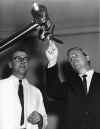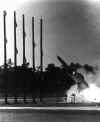1964
FY 64 The Aircraft Directional Control Anti-Tank (ADCAT) program was established early this year to demonstrate the accuracy potential of the directional-control guidance system proposed for a point-target weapon system to be fired from Army aircraft.
1 January 64 The MICOM Commander, BG John G. Zierdt, was promoted to major general.
February 64 The first overseas deployment of the PERSHING I occurred when the 248th General Support Unit went to Europe during this month. The 4th Missile Battalion of the 41st Artillery arrived in April.
27 February 64 The AMC Technical Committee reclassified the LACROSSE as obsolete.
March 64 The first GERMAN PERSHING I wing began unit training at Fort Sill. This unit completed its training and graduation firings in May 64.
March 64 The SERGEANT project started to plan for the orderly transition from full staffing to deprojectization. SERGEANT was the first large project to undergo phase-down operations. Its experience revealed that the biggest problem facing project managers was the reassignment of personnel, particularly high-grade employees.
March 64 MICOM's prominent role in cancer research was first made public. In cooperation with the National Cancer Institute and the National Institutes of Health, the command's Electromagnetics Laboratory used a laser in treating cancer in mice.

12 March 64 Redstone Arsenal's new $4.4 million research and development facility, designated as the Francis J. McMorrow Missile Laboratories, was dedicated.


27 March 64 The earthquake which struck Alaska on this date damaged 36 NIKE HERCULES missiles of the Able Battery of the 4th Missile Battalion. The HERCULES Project Office and MUCOM sent personnel to assess the extent of damage and to aid the U.S. Army, Alaska (USARAL) to restore the missiles to operational status.

1 April 64 The REDEYE Project Office was established at MICOM. Development of this system had been initiated on 30 June 59.


3 April 64 A MAULER Program Management Charter was instituted on this date. Revised on 13 May, the charter stated the mission, organization, functions, and operating methods to be used in managing the MAULER program. The outstanding accomplishment in this new method of management was the cooperation and coordination between government and contractor.

|
May 64 MICOM submitted plans to modify existing facilities to accommodate AMC Headquarter's announced plans for the establishment of an AMC Command and Control Communications Network. One feature of the plan involved the interconnection of higher headquarter's war room/operations center and similar facilities at each major subordinate command (MSC). The MICOM modifications were designed to address this plan. |
|
May 64 MG John G. Zierdt broke ground for the new Army Inertial Guidance and Control Laboratory addition to the McMorrow Missile Laboratories. |
|
23 June 64 MICOM spearheaded DOD's massive drive, known as Zero Defects, to re-emphasize pride in workmanship and to bolster quality achievements throughout American industry. The command hosted a special seminar on its Zero Defects program to provide a pattern for implementing a DOD-wide prevention program which could be used by all military and industrial organizations. This conference was the first such event ever held by a DOD agency. |
|
25 June 64 The REDSTONE missile, replaced by the PERSHING I, was classified obsolete. |
|
25 June 64 The last CORPORAL artillery unit was inactivated. |
|
1 July 64 The CORPORAL missile system was reclassified obsolete. |
|
1 July 64 MICOM relinquished responsibility for Watertown Arsenal to AMC. However, MICOM retained the missile container mission. |
|
1 July 64 The Air Defense Fire Distribution Systems Office was created at MICOM. As the successor to the U.S. Army Air Defense Engineering Agency at Fort Meade, Maryland, the new office was responsible for developing equipment to survey the air space, assign air defense missile units to areas of responsibility, and control the firepower for units. |
|
19 July 64 The Secretary of Defense approved the termination of the MAULER program. |
|
23 July 64
The AMC Technical Committee approved the Standard Type "A" classification of the XM22 Armament Subsystem.
|
|
August 64 DA decided on one nuclear warhead instead of two for the LANCE. |
|
31 August 64 Two major collections of scientific and technical reports merged, combining the formerly separate but similar services provided by the Defense Documentation Center Field Office and the Redstone Scientific Information Center (RSIC). The field office was terminated. The Army Research Office approved the merger, which extended RSIC's collection by the addition of 234,000 microfilm documents. |
|
September 64 MG John G. Zierdt announced that he planned to continue the DCG staffing because the concept was operating satisfactorily and managing efficiently. In addition, the commander's goal of a stable organization had been reached. |
|
21 September 64 An independent project management office (PMO) for SHILLELAGH was established at MICOM. The Weapons Command continued its project management of the SHERIDAN tank. |

|
|
21 September 64 The first known missile to fly with a pure fluid, no-moving-part control system was flight tested at RSA. |
|
October 64 The Joint Chiefs of Staff (JCS) directed that the Commander in Chief, U.S. Army, Europe (USAREUR) conduct an operational test program, including demonstration and shakedown operations; operational tests; and follow-on tests, to determine the reliability of the PERSHING I. This was the first Army missile system to undergo such a test program, joining the U.S. Air Force's (USAF's) TITAN and MINUTEMAN as well as the Navy's POLARIS. |
|
1 October 64 The TOW missile system became project managed at MICOM. The system had previously been managed by the Antitank/Aircraft Weapons Commodity Office at MICOM, which had been established on 19 November 62. |
|
15 October 64 The Secretary of Defense directed that the Army Air Defense System for the 1970s (AADS-70s) program name be changed to Surface-to-Air Missile, Development (SAM-D). |

|
|
16 October 64 Management functions for the REDSTONE missile system were transferred from the HONEST JOHN / LITTLEJOHN / REDSTONE Commodity Office to the Directorate of Supply and Maintenance. |
|
December 64 The Secretary of Defense approved the possible CHAPARRAL for further study and military potential tests. |

|

|
Excellence in Missilery:
Introduction,
1962,
1963,
1964,
1965,
1966,
1967,
1968,
1969,
1970,
1971,
1972,
1973,
1974,
1975,
1976,
1977,
1978,
1979







